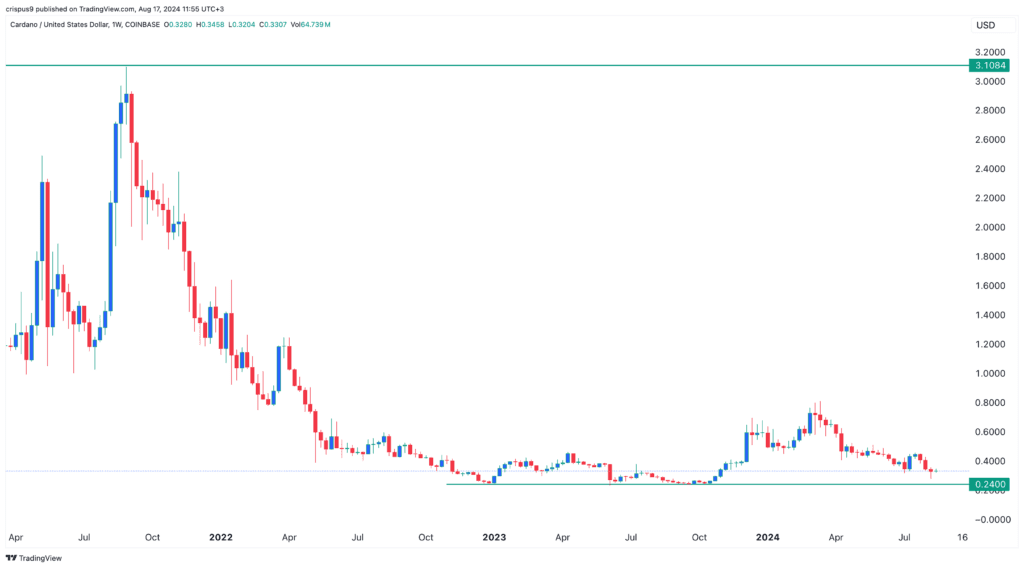Charles Hoskinson’s Cardano And The $11 Billion Crypto Ghost Chain
Cardano price has been under intense pressure in the past few months and is slowly nearing its all-time low. ADA, its token, has dropped in the past three consecutive months and was trading at $0.3305 on Saturday. If this trend continues, the coin could drop to its record low of $0.2400 soon.
Cardano has been in a steady downtrend since 2021 when it peaked at $3.1. In this period, its market cap has dropped from a record high of $91 billion to $11 billion, making it one of the worst-performing coins in the industry.
Still, $11 billion is a lot of money and it means that Cardano has a bigger market cap than well-known companies like Qorvo, Vivendi, Carrefour, and Chesapeake Energy, which bring in billions of dollars each year.
(Click on image to enlarge)

Cardano price chart
Biggest bubble in crypto
The crypto industry is a complicated one and is made up of many bubbles. For example, all meme coins have a market cap of over $38 billion, with Dogecoin, Shiba Inu, and Pepe being the market leaders.
The industry is also made up of many ghost chains; layer 1 and layer 2 networks that have no activity underneath it. Some of the most notable ones are Zilliqa, Kadena, and Velas.
With meme coins, however, investors know what they are getting into. Indeed, some analysts believe that these tokens have a utility in that they are highly volatile and liquid, making them ideal for day traders.
Cardano is a different story. Started in 2017 by Charles Hoskinson, the platform’s goal was to be a better alternative to Ethereum, the biggest layer 1 chain in the world. Unlike Ethereum, which was a proof-of-work network at the time, Cardano was a proof-of-stake platform that was fast and had low transaction costs.
Cardano’s claim to fame was that it was the first blockchain network to be founded on peer-reviewed research. Additionally, Hoskinson, like Polkadot’s Jed McCaleb, was also a founding member of Ethereum.
Its popularity exploded in 2021 as the Environmental Societal and Governance (ESG) craze was spreading. At the time, many crypto investors moved to Cardano, which they believed was the best alternative to Ethereum. Most of them bought the token and pushed its market cap to over $91 billion.
Cardano and the Ethiopian project
As Cardano’s popularity rose, the developers continued making headlines in a bid to pump the token’s price.
Their most ambitious project was to ink a partnership with Ethiopia’s Ministry of Education. In that deal, Cardano’s blockchain would be used to radically change the country’s education system by bringing it on-chain.
Students would be registered in the blockchain and their data would remain there for life. It would also be available to all stakeholders, including potential employers.
However, over four years since the project was announced, no detail has been made public by both Cardano and Ethiopia. The two sides did not respond to our emailed statement.
Cardano also launched another project in Tanzania, to connect the unconnected people to the banking industry. Like its Ethiopian project, this announcement led to hype but nothing has come out of it.
Cardano is mostly a ghost chain
As mentioned above, valuing a blockchain is difficult, since unlike stocks, we cannot use metrics like price-to-earnings (P/E) or price-to-sales (P/S) ratios.
However, for a layer-1 network like Cardano, we can look at some important data to see whether its valuation makes sense.
Cardano has two primary roles. First, users can use the ADA token as a means of payment. However, as with other coins, many people opt for stablecoins like Tether and USD Coin to do that since they are not volatile.
The other role is that it is used by developers to launch their projects. Decentralized Finance (DeFi) has become one of the biggest use cases for these projects. Looking at Cardano, we see that it has just $182 million in total value locked (TVL) and 20,500 active addresses.

Cardano DeFi TVL
In contrast, Arbitrum, a layer-2 network has over $2.6 billion and 366,000 active addresses. Yet, Arbitrum’s ARB token has a market cap of just $1.7 billion. The same is true with other chains like Blast, Avalanche, and Polygon.
Looking at Cardano’s ecosystem shows that its dApps are not popular. MinSwap, its biggest DEX, has over $48 million in TVL, and according to CoinMarketCap, it handled just $126,000 in volume in the past 24 hours. SundaeSwap only handled $41,000 in volume.
Liqwid, Cardano’s biggest lending marketplace, has just $27 million in assets and activity in the network is not all that strong.
Most importantly, Cardano has only $13 million in stablecoins, a figure that is significantly smaller than other chains. Tron and Ethereum have over $130 billion in combined stablecoin volume.
The same is true across other industries in the crypto industry. For example, while Ethereum handled $3.8 billion in NFT sales in the last 24 hours, Cardano’s sales stood at $34,000. In the last 30 days, Cardano’s NFT sales stood at just $1 million.
Cardano, unlike Solana and Base, has no presence in the meme coin in the meme coin, metaverse, and gaming industries.

Blockchain fees in 2024
Additional data shows that Cardano is not making any money. As shown above, Cardano does not appear in a ranking of the most profitable players in the crypto industry this year. It has been beaten by the likes of Base, Athena, and Convex Finance.
All this means that it is hard to justify Cardano’s $11 billion valuation, making it the biggest ghost chain in the world.
More By This Author:
Gold Prices Surge To Record $2,490 Amid Geopolitical Tensions And Mixed Economic SignalsAMD Nears Technical ‘Death Cross’
Rising Tesco, Marks & Spencer Shares Are Getting Overbought
Disclosure: Invezz is a place where people can find reliable, unbiased information about finance, trading, and investing – but we do not offer financial advice and users should always ...
more


